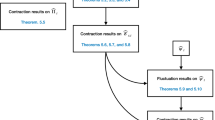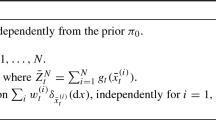Abstract
Data assimilation refers to the methodology of combining dynamical models and observed data with the objective of improving state estimation. Most data assimilation algorithms are viewed as approximations of the Bayesian posterior (filtering distribution) on the signal given the observations. Some of these approximations are controlled, such as particle filters which may be refined to produce the true filtering distribution in the large particle number limit, and some are uncontrolled, such as ensemble Kalman filter methods which do not recover the true filtering distribution in the large ensemble limit. Other data assimilation algorithms, such as cycled 3DVAR methods, may be thought of as controlled estimators of the state, in the small observational noise scenario, but are also uncontrolled in general in relation to the true filtering distribution. For particle filters and ensemble Kalman filters it is of practical importance to understand how and why data assimilation methods can be effective when used with a fixed small number of particles, since for many large-scale applications it is not practical to deploy algorithms close to the large particle limit asymptotic. In this paper, the authors address this question for particle filters and, in particular, study their accuracy (in the small noise limit) and ergodicity (for noisy signal and observation) without appealing to the large particle number limit. The authors first overview the accuracy and minorization properties for the true filtering distribution, working in the setting of conditional Gaussianity for the dynamics-observation model. They then show that these properties are inherited by optimal particle filters for any fixed number of particles, and use the minorization to establish ergodicity of the filters. For completeness we also prove large particle number consistency results for the optimal particle filters, by writing the update equations for the underlying distributions as recursions. In addition to looking at the optimal particle filter with standard resampling, they derive all the above results for (what they term) the Gaussianized optimal particle filter and show that the theoretical properties are favorable for this method, when compared to the standard optimal particle filter.
Similar content being viewed by others
References
Akashi, H. and Kumamoto, H., Random sampling approach to state estimation in switching environments, Automatica, 13(4), 1977, 429–434.
Atar, R. and Zeitouni, O., Exponential stability for nonlinear filtering, Annales de l’IHP Probabilitiés et statistiques, 33, 1997, 697–725,.
Bauer, P., Thorpe, A. and Brunet, G., The quiet revolution of numerical weather prediction, Nature, 525(7567), 2015, 47–55.
Blömker, D., Law, K., Stuart, A. M. and Zygalakis, K. C., Accuracy and stability of the continuous-time 3DVAR filter for the Navier-Stokes equation, Nonlinearity, 26(8), 2013, 2193.
Budhiraja, A. and Ocone, D., Exponential stability of discrete-time filters for bounded observation noise, Systems & Control Letters, 30(4), 1997, 185–193.
Burgers, G., Leeuwen, P. J. V. and Evensen, G. Analysis scheme in the ensemble Kalman filter, Monthly Weather Review, 126(6), 1998, 1719–1724.
Chorin, A. J. and Tu, X. M., Implicit sampling for particle filters, Proceedings of the National Academy of Sciences, 106(41), 2009, 17249–17254.
Crisan, D. and Heine, K., Stability of the discrete time filter in terms of the tails of noise distributions, Journal of the London Mathematical Society, 78(2), 2008, 441–458.
Moral, P. D., Kurtzmann, A. and Tugaut, J., On the stability and the uniform propagation of chaos of extended ensemble Kalman-Bucy filters, 2016, arXiv:1606.08256.
Douc, R., Fort, G., Moulines, E. and Priouret, P., Forgetting the initial distribution for hidden Markov models, Stochastic Processes and Their Applications, 119(4), 2009, 1235–1256.
Douc, R., Moulines, E. and Olsson, J., Optimality of the auxiliary particle filter, Probability and Mathematical Statistics, 29(1), 2009, 1–28.
Doucet, A., Freitas, N. D. and Gordon, N., An introduction to sequential Monte Carlo methods, Sequential Monte Carlo Methods in Practice, Springer-Verlag, New York, 2010.
Doucet, A., Godsill, S. and Andrieu, C., On sequential Monte Carlo sampling methods for Bayesian filtering, Statistics and Computing, 10(3), 2000, 197–208.
Evensen, G., Using the extended Kalman filter with a multilayer quasi-geostrophic ocean model, Journal of Geophysical Research: Oceans, 97(C11), 1992, 17905–17924.
Evensen, G., The ensemble Kalman filter: Theoretical formulation and practical implementation, Ocean Dynamics, 53(4), 2003, 343–367.
Ghil, M. and Malanotte-Rizzoli, P., Data assimilation in meteorology and oceanography, Advances in Geophysics, 33, 1991, 141–266.
Handel, R. V., The stability of conditional Markov processes and Markov chains in random environments, The Annals of Probability, 37(5), 2009, 1876–1925.
Harlim, J. and Majda, A. J., Catastrophic filter divergence in filtering nonlinear dissipative systems, Communications in Mathematical Sciences, 8(1), 2010, 27–43.
Houtekamer, P. L. and Mitchell, H. L., Ensemble Kalman filtering, Quarterly Journal of the Royal Meteorological Society, 131(613), 2005, 3269–3289.
Johansen, A. M. and Doucet, A., A note on auxiliary particle filters, Statistics & Probability Letters, 78(12), 2008, 1498–1504.
Kelly, D., Majda, A. J. and Tong, X. T., Concrete ensemble Kalman filters with rigorous catas-trophic filter divergence, Proceedings of the National Academy of Sciences, 112(34), 2015, 10589–10594.
Kelly, D., Vanden-Eijnden, E. and Weare, J., Personal Communications, 2016.
Kelly, D. T. B., Law, K. J. H. and Stuart, A. M., Well-posedness and accuracy of the ensemble Kalman filter in discrete and continuous time, Nonlinearity, 27(10), 2014, 2579.
Kleptsyna, M. L. and Veretennikov, A. Y., On discrete time ergodic filters with wrong initial data, Probability Theory and Related Fields, 141(3-4), 2008, 411–444.
Kunita, H., Asymptotic behavior of the nonlinear filtering errors of Markov processes, Journal of Multivariate Analysis, 1(4), 1971, 365–393.
Law, K., Stuart, A. and Zygalakis, K., Data Assimilation, Springer-Verlag, New York, 2015.
Law, K. J. H., Sanz-Alonso, D., Shukla, A. and Stuart, A. M., Filter accuracy for the Lorenz 96 model: fixed versus adaptive observation operators, Physica D: Nonlinear Phenomena, 325, 2016, 1–13.
Law, K. J. H., Shukla, A. and Stuart, A. M., Analysis of the 3DVAR filter for the partially observed Lorenz ’63 model, Discrete and Continuous Dynamical Systems A, 34, 2014, 1061–1078.
Law, K. J. H., Tembine, H. and Tempone, R., Deterministic mean-field ensemble Kalman filtering, 2014, arXiv:1409.0628.
Leeuwen, P. J. V., Particle filtering in geophysical systems, Monthly Weather Review, 137(12), 2009, 4089–4114.
Leeuwen, P. J. V., Nonlinear data assimilation in geosciences: An extremely efficient particle filter, Quarterly Journal of the Royal Meteorological Society, 136(653), 2010, 1991–1999.
Liu, J. S. and Chen, R., Blind deconvolution via sequential imputations, Journal of the American Statistical Association, 90(430), 1995, 567–576.
Lorenc, A. C., Analysis methods for numerical weather prediction, Quarterly Journal of the Royal Meteorological Society, 112(474), 1986, 1177–1194.
Majda, A. J. and Harlim, J., Filtering Complex Turbulent Systems, Cambridge University Press, Cambridge, 2012.
Majda, A. J. and Tong, X. T., Robustness and accuracy of finite ensemble Kalman filters in large dimensions, 2016, arXiv:1606.09321.
Moodey, A. J. F., Lawless, A. S., Potthast, R. W. E. and Leeuwen, P. J. V., Nonlinear error dynamics for cycled data assimilation methods, Inverse Problems, 29(2), 2013, 025002.
Pitt, M. K. and Shephard, N., Filtering via simulation: Auxiliary particle filters, Journal of the American Statistical Association, 94(446), 1999, 590–599.
Poyiadjis, G., Doucet, A. and Singh, S. S., Particle approximations of the score and observed information matrix in state space models with application to parameter estimation, Biometrika, 98(1), 2011, 65–80.
Rebeschini, P. and Handel, R. V., Can local particle filters beat the curse of dimensionality? The Annals of Applied Probability, 25(5), 2015, 2809–2866.
Sanz-Alonso, D. and Stuart, A. M., Long-time asymptotics of the filtering distribution for partially observed chaotic dynamical systems, SIAM/ASA Journal on Uncertainty Quantification, 3(1), 2015, 1200–1220.
Sedigh-Sarvestani, M., Albers, D. J., and Gluckman, B. J., Data assimilation of glucose dynamics for use in the intensive care unit, 2012 Annual International Conference of the IEEE Engineering in Medicine and Biology Society, IEEE, 2012, 5437–5440.
Sedigh-Sarvestani, M., Schiff, S. J. and Gluckman, B. J., Reconstructing mammalian sleep dynamics with data assimilation, PLoS Comput Biol, 8(11), 2012, e1002788.
Snyder, C., Particle filters, the “optimal” proposal and high-dimensional systems, Proceedings of the ECMWF Seminar on Data Assimilation for Atmosphere and Ocean, 2011.
Snyder, C., Bengtsson, T. and Morzfeld, M., Performance bounds for particle filters using the optimal proposal, Monthly Weather Review, 143(11), 2015, 4750–4761.
Tadic, V. Z. B. and Doucet, A., Asymptotic properties of recursive maximum likelihood estimation in non-linear state-space models, 2018, arXiv:1806.09571.
Thrun, S., Particle filters in robotics, Proceedings of the Eighteenth Conference on Uncertainty in artificial Intelligence, Morgan Kaufmann Publishers Inc., San Francisco, CA, 2002, 511–518.
Tong, X. T. and Handel, R. V., Ergodicity and stability of the conditional distributions of nondegenerate Markov chains, Annals of Applied Probability, 22(4), 2012, 1495–1540.
Tong, X. T., Majda, A. J. and Kelly, D., Nonlinear stability of the ensemble Kalman filter with adaptive covariance inflation, Communications in Mathematical Sciences, 14(5), 2016, 1283–1313.
Tong, X. T., Majda, A. J. and Kelly, D., Nonlinear stability and ergodicity of ensemble based Kalman filters, Nonlinearity, 29(2), 2016, 657.
Work, D. B., Blandin, S., Tossavainen, O. P. and et al., A traffic model for velocity data assimilation, Applied Mathematics Research Express, 2010(1), 2010, 1–35.
Zaritskii, V. S., Svetnik, V. B. and Šimelevišc, L. I., Monte-Carlo technique in problems of optimal information processing, Avtomatika i Telemekhanika, 36(12), 1975, 95–103.
Acknowledgements
DK was supported as an NYU-Courant instructor. The authors are grateful to an anonymous referee for comments on an earlier version of this paper which have led to a correction of the presentation in Subsection 2.2, and pointers to relevant literature that were previously omitted; they are also grateful to Jonathan Mattingly for discussions relating to ergodicity of nonlinear Markov processes, and to Arnaud Doucet and Adam Johansen for helpful pointers to the literature. The authors also highlight, on the occasion of his 70th birthday, the inspirational work of Andy Majda, in applied mathematics in general, and in the area of data assimilation and filtering (the subject of this paper) in particular.
Author information
Authors and Affiliations
Corresponding authors
Additional information
This work was supported by EPSRC (EQUIPS Program Grant), DARPA (contract W911NF-15-2-0121) and ONR (award N00014-17-1-2079).
Rights and permissions
About this article
Cite this article
Kelly, D., Stuart, A.M. Ergodicity and Accuracy of Optimal Particle Filters for Bayesian Data Assimilation. Chin. Ann. Math. Ser. B 40, 811–842 (2019). https://doi.org/10.1007/s11401-019-0161-5
Received:
Published:
Issue Date:
DOI: https://doi.org/10.1007/s11401-019-0161-5




